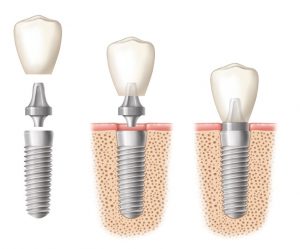Header logo
header top contact widget
Learn More Blog
Dental Implants – Understanding Their Components
Posted on Jan 18, 2017 by William J. Claiborne, DDS MS
They say knowledge is power. I believe the more a patient understands, the better participants they become in managing their oral health. When considering Dental Implants to replace missing teeth, understanding how the different components of an implant system works is the first step for patients, in my opinion.
Even though there are different types of implants to accommodate various needs, most systems work in the same way. Read on for a simple explanation of how implants are structured.
A Dental Implant is not a replacement tooth (or teeth). The tooth attached to the implant is actually a crown, or in some cases, a bridge of two or more teeth or a full arch (denture). The teeth are actually referred to as restorations, because they restore the look, feel and function of natural teeth.
The implant is actually the portion placed in the jaw. An insertion point is made in the bone and the implant, a hollow screw-like cylinder, is placed. In most cases, the implants are recovered with gum tissue and allowed to heal for several months. During this time, you’ll be able to wear a denture or temporary teeth comfortably.
In the healing period, your jaw bone will grow around the implant, securing it in place. This process is known as osseo-integration, or integrating the implant with the bone. This recreates the presence of natural tooth roots, assuring biting and chewing stability.
After the healing process, the gum tissue is uncovered and a post is secured inside the implant. Onto this post, your final replacement tooth or teeth are attached.
An important aspect of successful Dental Implant treatment is in the selection and placement process. This is where a doctor who is highly trained and experienced is important. Sufficient bone mass must exist to hold the implant and adequately support the teeth being attached. By strategic placement at a proper depth, as few as 4 – 6 implants can support a full arch.
When bone loss is severe, bone rebuilding procedures can be performed prior to implant placement. This does not necessarily involve bone grafting. Additionally, some implant systems are designed to be placed at specific angles. This gives each implant the ability to support teeth without requiring much bone depth.
The type of Dental Implant system best suited for your needs can be discussed during a Consultation. As a Periodontist, I have advanced training and skills in the diagnosis an placement of all types of implants. During this time, I’ll explain options that will work best for you and answer your questions.
Call (828) 274-9440 to schedule a time when we can meet personally.
Recent Posts
Categories
Archives
- September 2024
- August 2024
- July 2024
- June 2024
- May 2024
- April 2024
- March 2024
- February 2024
- January 2024
- December 2023
- November 2023
- October 2023
- September 2023
- August 2023
- July 2023
- June 2023
- May 2023
- April 2023
- March 2023
- February 2023
- January 2023
- December 2022
- November 2022
- October 2022
- September 2022
- August 2022
- July 2022
- June 2022
- May 2022
- April 2022
- March 2022
- February 2022
- January 2022
- December 2021
- November 2021
- October 2021
- September 2021
- August 2021
- July 2021
- June 2021
- May 2021
- April 2021
- March 2021
- February 2021
- January 2021
- December 2020
- November 2020
- October 2020
- September 2020
- August 2020
- July 2020
- June 2020
- May 2020
- April 2020
- March 2020
- February 2020
- January 2020
- December 2019
- November 2019
- October 2019
- September 2019
- August 2019
- July 2019
- June 2019
- May 2019
- April 2019
- March 2019
- February 2019
- January 2019
- December 2018
- November 2018
- October 2018
- September 2018
- August 2018
- July 2018
- June 2018
- May 2018
- April 2018
- March 2018
- February 2018
- January 2018
- December 2017
- November 2017
- October 2017
- September 2017
- August 2017
- July 2017
- June 2017
- May 2017
- April 2017
- March 2017
- February 2017
- January 2017
- December 2016
- November 2016
- October 2016
- September 2016
- August 2016
- July 2016
- June 2016
- May 2016
- April 2016
- March 2016
- February 2016
- January 2016
- December 2015
- November 2015
- October 2015
- September 2015
- August 2015
- July 2015
- June 2015
- May 2015
- April 2015
- March 2015
- February 2015
- January 2015
- December 2014
- November 2014
- October 2014
- September 2014
- August 2014
- July 2014
- June 2014
- May 2014
- April 2014
- March 2014
- February 2014
- January 2014
- December 2013
- November 2013
- October 2013
- September 2013
- August 2013
- July 2013
- June 2013
- May 2013
- April 2013
- March 2013
- February 2013
- January 2013
- December 2012
- November 2012
- October 2012
- September 2012
- August 2012
- July 2012
- June 2012

